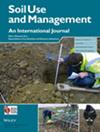How much do conservation cropping practices mitigate runoff and soil erosion under Western European conditions: A focus on conservation tillage, tied ridging and winter cover crops
IF 3.7
3区 农林科学
Q1 SOIL SCIENCE
引用次数: 0
Abstract
Conservation farming practices are known for their capacity to mitigate runoff and erosion, but the magnitude of their effectiveness is highly variable across studies. In order to better understand the contribution of environmental and management factors to their effectiveness, up to 37 studies reporting 271 individual trials were collated for a quantitative review regarding 3 common conservation agriculture‐related practices, at the plot scale and in a Western European context. Two different methods suitable for hierarchically structured data sets were used for the meta‐analyses—hierarchical nonparametric bootstrapping and linear random effects models—, yielding nearly identical average outcomes but differing in terms of confidence intervals. We found that, on average, winter cover crops reduce cumulative seasonal (autumn‐winter) runoff by 68% and soil losses by 72% compared with a bare soil. The occurrence and intensity of stubble tillage on the control plot is a key explanatory variable for the mitigation effect of winter cover crops. In potato crops, tied ridging reduces cumulative seasonal (spring–summer) runoff by a mean of 70% and soil erosion by 92%. Conservation (non‐inversion) tillage techniques alleviate cumulative seasonal overland flow by 27% and associated sediments losses by 66%, but strong evidence of publication bias was detected for this farming practice, probably leading to an overestimation of its effectiveness. These mitigation effects are shown to be much greater for spring crops than for winter crops, and to increase with time since ploughing was stopped. The type of conservation tillage scheme strongly affects the ability to attenuate surface flows. Intensive non‐inversion tillage systems relying on repeated use of (powered) tillage operations appear to be the least effective for reducing both water and sediment losses. The best performing scheme against runoff would be a deep (non‐inversion) tillage (−61%), while against erosion it would be a no‐till system (−82%). Although several explanatory factors were identified, there remains a high (unexplained) variability between trials effect sizes, thus not attributable to pure sampling variability. Meanwhile, this review provides farm advisors or policy makers with guidance on the contexts in which implementation of such conservation practices should be supported so as to maximize expected benefits.在西欧条件下,保护性耕作方法能在多大程度上减少径流和土壤侵蚀:重点关注保护性耕作、绑扎田埂和冬季覆盖作物
众所周知,保护性耕作方法具有减少径流和侵蚀的能力,但其有效性的大小在不同的研究中存在很大差异。为了更好地了解环境和管理因素对其有效性的影响,我们整理了多达 37 项研究,报告了 271 项单独试验,以西欧为背景,对 3 种常见的保护性耕作方法进行了地块规模的定量审查。荟萃分析采用了两种适合分层结构数据集的不同方法--分层非参数引导法和线性随机效应模型,得出的平均结果几乎相同,但在置信区间方面有所不同。我们发现,与裸露土壤相比,冬季覆盖作物平均可减少 68% 的累积季节性(秋冬季)径流和 72% 的土壤流失。对照地块上茬耕的发生和强度是冬季覆盖作物缓解效果的一个关键解释变量。在马铃薯作物上,绑埂平均可减少 70% 的季节性(春夏季)累积径流和 92% 的土壤侵蚀。保护性(非逆转)耕作技术可使累积季节性溢流减少 27%,相关沉积物损失减少 66%,但在这种耕作方法上发现了强烈的出版偏差证据,可能导致对其效果的高估。研究表明,春播作物比冬播作物的减缓效果要大得多,而且随着停止耕作时间的延长,减缓效果也会增加。保护性耕作方案的类型对地表水流的减缓能力有很大影响。依靠反复使用(动力)耕地作业的密集型非逆转耕地系统在减少水和泥沙流失方面似乎最不有效。针对径流效果最好的方案是深耕(非翻转)(-61%),而针对侵蚀效果最好的方案是免耕系统(-82%)。虽然确定了几个解释因素,但试验效果大小之间仍存在很大的差异(无法解释),因此不能归因于纯粹的取样差异。同时,本综述为农场顾问或政策制定者提供了指导,帮助他们了解应在何种情况下支持实施此类保护措施,以实现预期效益最大化。
本文章由计算机程序翻译,如有差异,请以英文原文为准。
求助全文
约1分钟内获得全文
求助全文
来源期刊

Soil Use and Management
农林科学-土壤科学
CiteScore
7.70
自引率
13.20%
发文量
78
审稿时长
3 months
期刊介绍:
Soil Use and Management publishes in soil science, earth and environmental science, agricultural science, and engineering fields. The submitted papers should consider the underlying mechanisms governing the natural and anthropogenic processes which affect soil systems, and should inform policy makers and/or practitioners on the sustainable use and management of soil resources. Interdisciplinary studies, e.g. linking soil with climate change, biodiversity, global health, and the UN’s sustainable development goals, with strong novelty, wide implications, and unexpected outcomes are welcomed.
 求助内容:
求助内容: 应助结果提醒方式:
应助结果提醒方式:


